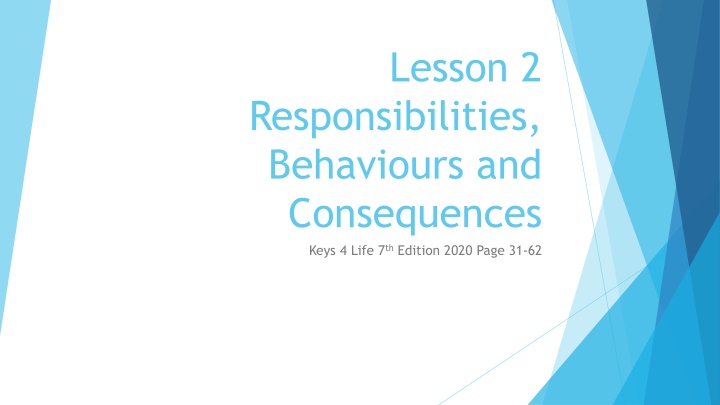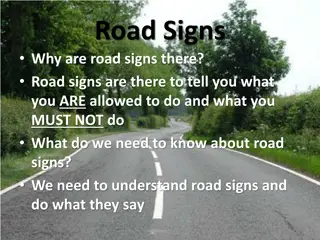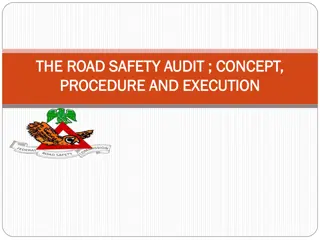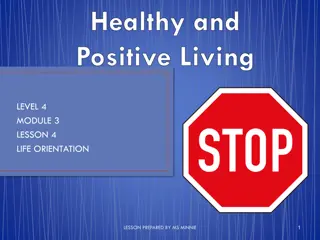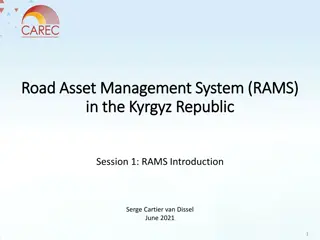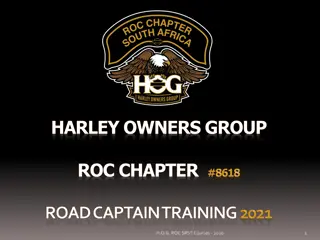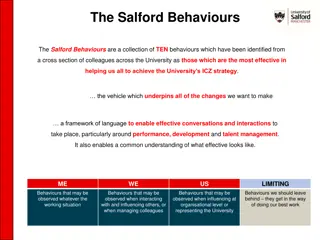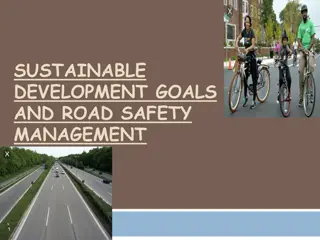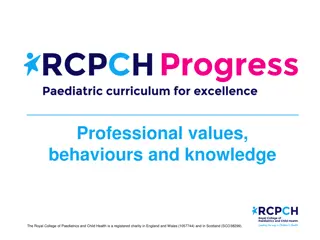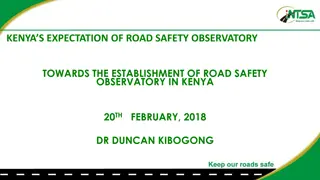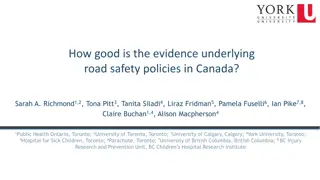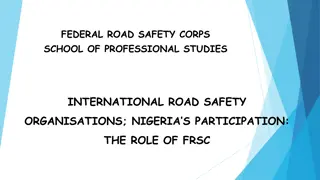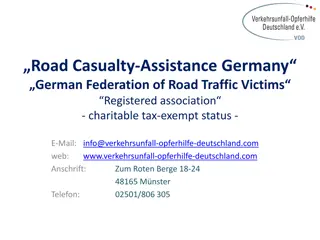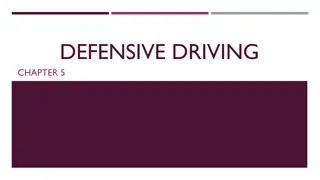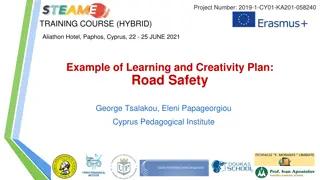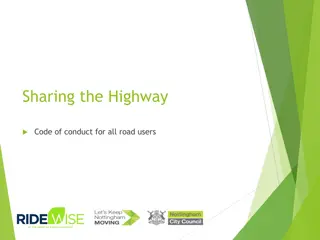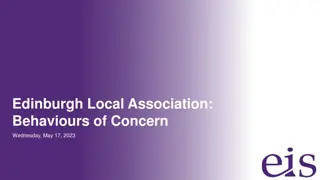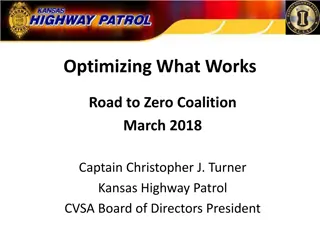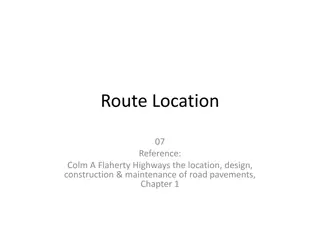Road User Responsibilities and Safety: Understanding Behaviours and Consequences
Explore the concepts of responsibilities, behaviours, and consequences associated with road users through activities and discussions. Learn about driver responsibilities, the impact of road rage, and ways to reduce crash risks. Reflect on personal driving pledges and understand the importance of safe driving practices for oneself and others.
Download Presentation

Please find below an Image/Link to download the presentation.
The content on the website is provided AS IS for your information and personal use only. It may not be sold, licensed, or shared on other websites without obtaining consent from the author.If you encounter any issues during the download, it is possible that the publisher has removed the file from their server.
You are allowed to download the files provided on this website for personal or commercial use, subject to the condition that they are used lawfully. All files are the property of their respective owners.
The content on the website is provided AS IS for your information and personal use only. It may not be sold, licensed, or shared on other websites without obtaining consent from the author.
E N D
Presentation Transcript
Lesson 2 Responsibilities, Behaviours and Consequences Keys 4 Life 7thEdition 2020 Page 31-62
Activity 2.1 Road User Responsibilities and Behaviours Page 34-36 Learning intention Outline driver responsibilities and the potential consequences of not being a safe driver Department of Transport: How to reduce your crash risk for novice drivers - Distractions
What do the following terms mean? RESPONSIBILITY PRIVILEGE RIGHT A special right enjoyed by a person that is given or earned. A particular load of care placed on someone who is responsible. Having a just claim or title to something. Is having a driver s licence and being able to drive a right or privilege?
Circle Talk 1. The community believes that all road users have a responsibility for their own safety and the safety of others. Do you think that all young people believe this too? Why? 2. Some drivers believe it is their right to intimidate other drivers. The media refers this as road rage . Why do some drivers act in this way? like? you feel? 4. If you were a learner driver and another driver acted aggressively incident didn t put you and other road aggressive drivers? when faced with an annoying situation? 3. What are the characteristics of a tolerant driver? An aggressive driver? What do their actions look and feel towards you while driving, how would users at risk? 5. What would you do to make sure the 6. What actions could you take to avoid 7. How can you control your own anger acceptable in any situation? Why? 8. Is aggressive or abusive behaviour
Road User Responsibilities Responsible driving and compliance with the road rules will enable drivers to enjoy the privileges and freedoms of having a driver s licence. Let s identify the key responsibilities of a learner driver, provisional driver, full licence driver and their passengers. What are your responsibilities as a passenger? What are your responsibilities as a L driver? What are your responsibilities as a red and green P plate driver? What are your responsibilities as a driver on a full licence?
Reflection Driver pledge I aim to be a driver who is: - - - Eg: calm, respectful, safe etc.
Activity 2.2 Responsibilities and Consequences Page 37-43 Learning intention Understand consequences of road crashes. Road Safety Commission Distance of Distraction Prams
Responsibilities and Consequences Consequences of not being responsible Driver responsibilities Learn and practice safe driving habits (i.e. travel at posted speeds) Loss of licence Demerit points and fines Legally obtain a driver s licence What about the passengers? Injury to self and others Obey the law/road rules Jail sentence What are their responsibilities? Show courtesy and respect to all road users Criminal record What are the potential consequence of passengers not being responsible
Sharing The Road with Respect Cyclists Heavy haulage & oversized vehicles Let s look at how a driver can respectfully share the road with the following groups of road users. Emergency responders & breakdown vehicles Other vehicles & buses Roadwork activities Pedestrians
Road Crashes - Consequences When a road crash happens, there are subsequent consequences that occur. These can be grouped into five different types of consequences. Legal Social Types of consequences Emotional Are these consequences relevant to just the vehicle occupants (i.e. driver, passenger? Who else can be impacted by a crash? Financial Physical
Road Crashes - Consequences When a road crash happens, there are subsequent consequences that occur. These can be grouped into seven different types of consequences. Figure 26.3 Strong Spirit Strong Mind: The Seven Areas used with permission by Casey, W (2014) Strong Spirit Strong Mind Model Informing Policy and Practice in Chapter 26 in Dudgeon P, Milroy H & Walker R. 2014, Working Together: Aboriginal and Torres Strait Islander Mental Health and Wellbeing Principles and Practice. Canberra: Australian Government Department of the Prime Minister and Cabinet, 2nd ed., pp.449-458.
Scenario You and your mates have had a few beers. Everyone gets in your car to go for a ride. Out on the road your mates get really loud and start to shout and muck around. You try to concentrate but you ve had too much to drink. Your car starts to skid on the gravel and you lose control. Two of your mates are killed.
Grouping Consequences Post Activity Discussion Would knowing the financial and legal consequences of a crash change the ways a young driver might use the roads? Why/Why not? Which consequences (i.e. physical, emotional, legal, social or financial had the most cards? The community wants young people to consider the consequences of poor driving decisions. What changes would someone need to make if they no longer had a driver s licence or access to a vehicle? Why might opinions differ from person to person? How could this be achieved? How would repaying thousands of dollars of expenses, not covered by insurance, impact someone s life? Which consequences of road crashes do most young people think about? Why?
Impacts and Consequences Every driver will respond differently when responding to the consequences of their actions. Some consequences can have a greater impact and some, little impact. Scenario A newly licenced driver has been involved in a crash. The crash was their fault as they had been speeding and overtaking another vehicle when it wasn t safe to do so. The crash resulted in a serious injury to the occupant of the other vehicle. The newly licenced driver did not have insurance cover. Least impact Greatest impact
Reflection Passenger pledge I aim to be a passenger who is: - - - Eg: calm, respectful, safe etc.
Learning intention Activity 2.3 Learning the road rules Pages 44-61 Apply road rules to different situations Road Safety Commission 154 Wrecking Ball 30s v3
Cryptic Signs What am I? Department of Transport: Drive Safe: https://www.transport.wa.gov.au/mediaFiles/licensing/DVS_DL_B_DriveSafeFull_o.pdf
Drive Safe Bingo Double continuous unbroken lines are used as dividing lines A controlled intersection is an intersection that has: traffic control signals; It is an offence not to is an adequate following YOU must not cross these Pre Driver Checks: Tyres Brakes Steering Lights side is severely reduced km/h unless a sign shows a different speed. 3.10.3 Pelican signals A pelican crossing works like normal traffic control signals, except that it h as an extra phase a flashing yellow light. Page 60 Page 26 directing traffic. Page 66 Page 56 A way of estimating what (centre lines) on roads. The distance that you can see ahead and to the Step 5 Practical driving a STOP or GIVE WAY sign; emergency vehicle. called the two second can cross them to turn The time it takes to stop a car depends on: reaction distance and Braking distance Horn after dark. Page 45 Page 40 a Police Officer or Page 43 U turn or enter or leave In a built-up area, the default speed limit is 50 give way to an distance is to use what is lines to overtake but you 0.00 per cent BAC You must not drink any alcoholic drinks at all if you intend to drive. Page 7 Page 44 Windscreen & wipers Mirrors other authorised person a road if it is safe to do so. for a car (C class) licence Page 29 assessment (PDA) Page 32 a roundabout; or Page 93 rule. right at an intersection,
Behind the wheel Quiz 3 Indicating and hand signals (page 22); Quiz 4 Intersections and turning (page 23); Quiz 5 Traffic signals and road markings (page 24); Quiz 6 Traffic signals (page 25) OR use Quizzes 1-5 in the Keys4Life student workbook. TASK 3: Tolerance and courtesy Behind the Wheel Journal Student Workbook What sort of driver do you want to be? page 3 page 6
Road Rule: Keeping Left Keep Left (Road Safety Commission)
Road driving vocabulary Create a list of unfamiliar words they might come up in the theory test! Blinkers (indicator) Infringement (against the road rules) Provisional driver (P plater) Traffic control signals (lights) Pedestrian crossing (person walking) Cyclist (push bike rider) Collision (crash)
Find out more From the Keys 4 Life teacher resource 2020 edition 7 Lesson 2 If necessary, refer students to the Road Trauma Support WA (RTSWA), a free counselling and advice service available at: http://www.rtswa.org.au/. Department of Transport Road rules theory test quiz https://www.transport.wa.gov.au/licensing/roadrules-theory-test-quiz.asp Road Safety Commission 12 Most asked about road rules (Videos, explanations and penalties) https://roadrules.rsc.wa.gov.au/ Department of Transport handbook https://www.transport.wa.gov.au/licensing/learner-activities-and-resources.asp Road Safety Commission Pre-trip preparation 101 (20 secs) https://roadrules.rsc.wa.gov.au/ https://www.youtube.com/watch?time_continue=7&v=S6Mpb6J49vc Road Safety Commission Slow down, Move Over (SLOMO) https://www.rsc.wa.gov.au/Rules-Penalties/Browse/Emergency-Vehicles
Website links from resource From the Keys 4 Life teacher resource 2020 edition 7 Students practise test questions with a parent or adult family member, using the eleven online sample quizzes at https://www.transport.wa.gov.au/licensing/road-rules-theory-test-quiz.asp Your Secure Identity (https://www.transport.wa.gov.au/licensing/proof-of- identity.asp) describes the five (5) forms of identity required for the application process, of which: FIND OUT MORE Department of Transport Road rules theory test quiz https://www.transport.wa.gov.au/licensing/road-rules-theory-test-quiz.asp
For teachers /agencies only Teachers register for the Portal by creating an access account at https://keys4life.ziparchive.com.au/. Have your Keys4Life Access Number ready and use it to log in to: www.northsidelogistics.com.au The Agency order form is available at: www.sdera.wa.edu.au/programs/keys4life/
